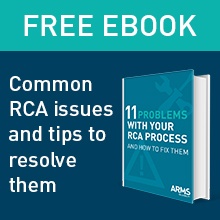By Kevin Stewart
With all the preparation work (Honing your Facilitation Skills: Part 1) behind you, you’re now ready to start facilitating an Apollo Root Cause Analysis. Follow the steps below to ensure a smooth process and successful outcome.

Step 1. Introductions
First, do some simple introductions and housekeeping. Cover things like:
- Introductions all around
- The meeting guidelines: when to take breaks, phone and email policy, and so on
- The objective: we’re here to fix the problem, not appoint blame
- A review of the Apollo Root Cause Analysis methodology for those who may not be familiar with it (spend 15 – 45 minutes depending on the audience)
- Your role as facilitator: you may need to ‘direct traffic’ or change the direction of discussions to help them discover more causes or to reach effective solutions
Step 2. Timeline
It’s now time to capture the ‘story’. What has happened that brought you all here? Get several people to provide a narrative, and develop a timeline of events as you go.
This timeline will prove very useful. It should reveal the event or issue that becomes your primary effect or starting point – and ensures that all the items beyond this starting point capture the group’s issues.
In the example below, if I start from T1 I’ll discover why I left my iPad in the bathroom. However if I start at T7 I will also discover why my check process didn’t function as desired.
| Date | Time | Event | Comment |
| T1 | Leave iPad in department restroom stall | ||
| T2 | Meet wife | ||
| T3 | Have lunch | ||
| T4 | Return to car to leave | ||
| T5 | Wife asks if we have everything before we leave | ||
| T6 | Pat pocket and look, run through check list | ||
| T7 | Head home without iPad | ||
| T8 | Get call halfway home asking if i have iPad |
While the time that each event occurs is important, it might not always be known. In these instances, you can represent the time sequence as simply T1, T2 and so on.
Step 3. Define the problem
You’re now ready to define the problem. Often, the problem definition comes out easily and everyone agrees. However, sometimes you’ll find that the group can’t arrive at a Primary Effect. In this case, as facilitator, it’s your job to regroup and ask some questions about why everyone is interested. Often, it’s about money.
One thing you don’t want to do is get stuck trying to find the perfect starting point. I’m reminded of a saying I heard once:
Dear Optimist and Pessimist,
While you were trying to decide if the glass was half empty or half full, I drank it!
Sincerely,
The Realist
The Apollo Root Cause Analysis methodology is robust enough to handle an imperfect starting point. If the problem changes or evolves as you go, just put it down as the new starting point, adjust the chart and go on!
Now that you have a defined problem, with its significance well understood, you’re now ready to start the charting process. The team should also know by now why they’re here, and how much time and money can be spent on the investigation.
If you missed Part 1 of this article, you can read it here.
Would you like to learn more about the Apollo Root Cause Analysis methodology? Our 2 Day Root Cause Analysis Facilitators course is perfect for anyone needing to understand fundamental problem solving processes and how to facilitate an effective investigation.

 What does an executive summary look like? Is it a dot point affair? Is it a few one-liners that capture the critical elements of the issue? Or do you tell a story that recreates everything? Is it something in-between?
What does an executive summary look like? Is it a dot point affair? Is it a few one-liners that capture the critical elements of the issue? Or do you tell a story that recreates everything? Is it something in-between?
